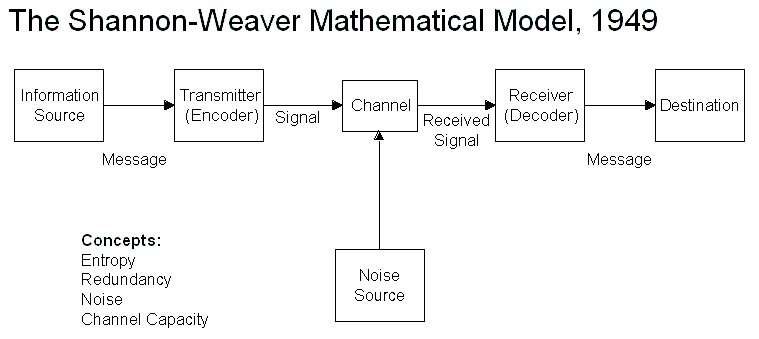
Shannon and Weaver's communication model consist of five elements:
- An information source, which produces a message.
- A transmitter, which encodes the message into signals
- A channel, to which signals are adapted for transmission
- A receiver, which 'decodes' (reconstructs) the message from the signal.
- A destination, where the message arrives.
The information source are the image and sound source, this could be a movie, a TV show, or a news program. However, the sound source are the audio signals that comes from the movie or news programs.
After that, the transmitter sends both the video and audio signal through the air wave(the channel) that will be received by the TV set in our home. It will then be decoded from radio wave into audio and video signals that can be processed into images and sound, which will be displayed on our television.
But there is a potential noise source that could disrupt the signals from being transmitted and received accurately, that is the weather. Raining and lightning storms makes the transmission less efficient and viewers at home might not able to receive any signals, lightnings are even able to damage our property.
There are different types of TVs, such as the CRT type, LCD type, or even the PDP(plasma) type display. However, different types of display and sound setup offers different viewing experience, which gives us redundant and entropic information.
One of the examples is watching a High Definition movie, such as the Transformers movie. Most people want to watch it because of its action, sound effects, and also the detail of the transformers itself, but it will be kind of pointless if we watch it on a 21'inch CRT television.
When watching on a lower resolution display, the movie becomes very redundant because the details that we're able to see is quite limited. However, the viewer has a high definition display system and also a surround sound system, this offers the viewer a much more enjoyable experience because it allows the viewer to see and hear something that could not be heard in a normal television.


hmm i would say watching Transformers on a small screen results in 'noise' issue. The message is not sent as completely as a wide screen. Every CG detail and panaromic shot is squeezed and becomes 'noisy'.
ReplyDelete